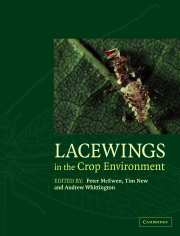Book contents
- Frontmatter
- Contents
- List of contributors
- Preface
- PART 1 Lacewing systematics and ecology
- PART 2 Lacewings in crops
- PART 3 Principles
- PART 4 Case studies
- Introduction to Part 4
- CHAPTER 18 Micromus tasmaniae: a key predator on aphids on field crops on Australasia?
- CHAPTER 19 Preliminary notes on Mallada signatus (Chrysopidae) as a predator in field crops in Australia
- CHAPTER 20 An evaluation of lacewing releases in North America
- CHAPTER 21 Chrysoperla externa and Ceraeochrysa spp.: potential for biological control in the New World tropics and subtropics
- CHAPTER 22 Comparative plant substrate specificity of Iberian Hemerobiidae, Coniopterygidae, and Chrysopidae
- CHAPTER 23 Lacewings in Sardinian olive groves
- CHAPTER 24 Lacewing occurrence in the agricultural landscape of Pianura Padana
- CHAPTER 25 Lacewings and snake-flies in Piedmont vineyards (northwestern Italy)
- CHAPTER 26 Control of aphids by Chrysoperla carnea on strawberry in Italy
- CHAPTER 27 Artificial overwintering chambers for Chrysoperla carnea and their application in pest control
- CHAPTER 28 Lacewings in Andalusian olive orchards
- CHAPTER 29 The green lacewings of Romania, their ecological patterns and occurrence in some agricultural crops
- CHAPTER 30 Biological control with Chrysoperla lucasina against Aphis fabae on artichoke in Brittany (France)
- PART 5 Conclusion
- Taxonomic index
- General index
CHAPTER 19 - Preliminary notes on Mallada signatus (Chrysopidae) as a predator in field crops in Australia
Published online by Cambridge University Press: 04 May 2010
- Frontmatter
- Contents
- List of contributors
- Preface
- PART 1 Lacewing systematics and ecology
- PART 2 Lacewings in crops
- PART 3 Principles
- PART 4 Case studies
- Introduction to Part 4
- CHAPTER 18 Micromus tasmaniae: a key predator on aphids on field crops on Australasia?
- CHAPTER 19 Preliminary notes on Mallada signatus (Chrysopidae) as a predator in field crops in Australia
- CHAPTER 20 An evaluation of lacewing releases in North America
- CHAPTER 21 Chrysoperla externa and Ceraeochrysa spp.: potential for biological control in the New World tropics and subtropics
- CHAPTER 22 Comparative plant substrate specificity of Iberian Hemerobiidae, Coniopterygidae, and Chrysopidae
- CHAPTER 23 Lacewings in Sardinian olive groves
- CHAPTER 24 Lacewing occurrence in the agricultural landscape of Pianura Padana
- CHAPTER 25 Lacewings and snake-flies in Piedmont vineyards (northwestern Italy)
- CHAPTER 26 Control of aphids by Chrysoperla carnea on strawberry in Italy
- CHAPTER 27 Artificial overwintering chambers for Chrysoperla carnea and their application in pest control
- CHAPTER 28 Lacewings in Andalusian olive orchards
- CHAPTER 29 The green lacewings of Romania, their ecological patterns and occurrence in some agricultural crops
- CHAPTER 30 Biological control with Chrysoperla lucasina against Aphis fabae on artichoke in Brittany (France)
- PART 5 Conclusion
- Taxonomic index
- General index
Summary
INTRODUCTION
The manipulative use of Chrysopidae as biological control agents in Australia is in its infancy. The family is well represented, with slightly more than 50 species described (New, 1996), but many of these are recorded only infrequently in Australia and occur almost entirely in forests and other naturally vegetated habitats. Many are also limited in their distribution within Australia. The species encountered most frequently in southern Australia are Apertochrysa edwardsi (Banks), Mallada innotatus (Walker), M. signatus (Schneider), and Plesiochrysa ramburi (Schneider). Indeed, a survey of Chrysopidae on native Acacia trees over three years in Victoria yielded only three species (A. edwardsi, M. signatus, P. ramburi), with A. edwardsi by far the most abundant (New, 1983). However, this species is predominantly arboreal, and has not been reported commonly on field crops. Apertochrysa edwardsi is Bassian, the two Mallada species are widespread in Australia, and P. ramburi occurs over much of the western Pacific region, where its larvae have been reported from many crops. The larvae of all these species were described by Boros (1984), but many details of their biology have not been clarified, and there are few records of their prey or feeding activity. However, they are clearly the most likely candidates among Australian Chrysopidae for investigation for their potential in biological control.
This note considers the potential for one of these common species, M. signatus, as a species currently attracting considerable attention as a polyphagous predator on pests of field crops.
ROLE IN BIOLOGICAL CONTROL
In eastern Australia, Mallada signatus is commonly found only in small numbers on field crops.
- Type
- Chapter
- Information
- Lacewings in the Crop Environment , pp. 395 - 397Publisher: Cambridge University PressPrint publication year: 2001
- 2
- Cited by



